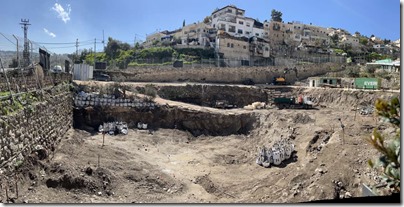“A 6,000-year-old copper fishing hook, possibly used for catching sharks or other large fish, has been discovered during an Israel Antiquities Authority excavation in Ashkelon.”
Andy Cook posts a short video he just filmed in the drainage channel underneath the City of David.
Sussita National Park is now open to the public. The site, also known as Hippos, overlooks the Sea of Galilee on its eastern side.
Bible History Daily addresses the question of who lived in the ancient city of Hazor: commoners, elites, or a mix of the two. This issue is explored further in an article by Shlomit Bechar in the latest issue of Biblical Archaeology Review.
Several dozen articles on the topic of “The Ancient Written Wor(l)d” have been published in the latest issue of ‘Atiqot (open access). One of the articles challenges the identification of the signet ring of Pilate.
“Jerusalem was named one of TIME magazine’s 50 most extraordinary travel destinations, as part of the publication’s third annual list of the World’s Greatest Places.”
“Caesarea was given awarded the ACTA Archeological and Cultural Award for the best foreign archeological site by GIST, Italy’s foremost tourism press agency.”
Chandler Collins will now be posting information about excavations and publications about Jerusalem on Facebook, Twitter, and Instagram.
As Emily Master steps down after five years as Executive Director of the Friends of the Israel Antiquities Authority, she identifies three milestone projects completed in this time: a renovated Davidson Center, the Shelby White and Leon Levy Lod Mosaic Archaeological Center, and the Jay and Jeanie Schottenstein National Campus for the Archaeology of Israel.
Aren Maeir’s latest publication is in a volume dedicated to Indiana Jones. (Despite the date of its posting, the book appears legitimate.)
New release: In the Shadow of the Wall: The Life and Death of Jerusalem’s Maghrebi Quarter, 1187–1967, by Vincent Lemire (Stanford University Press, $32; Amazon).
ASOR webinar on April 13: “New Perspectives on Jerusalem’s 7th Century BCE Elite,” by Yuval Gadot
Online lecture on April 27: “The Archaeology of Mount Zion in Jerusalem – Past, Present, and Future,” by Shimon Gibson. Registration is free and required.
On YouTube: “The Jewishness of the New Testament: An Interview with R. Steven Notley” (17 min)
Israeli authorities are forecasting severe heat waves this summer, with temperatures possibly reaching 120 degrees F (49 C).
The Infusion Bible Conference digital download of all 42 videos of “The Last Days of Jesus” is now on sale for $30 off. Purchase includes the pdf notebook with 170 pages of notes, resources, and recommendations.
Focus on the Family is celebrating Passion Week with a series of devotionals by Will Varner, illustrated with photos from BiblePlaces.com.
HT: Agade, Arne Halbakken, Alexander Schick, Explorator
